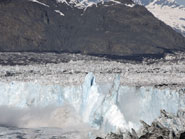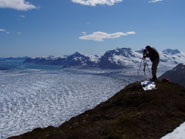14 July 2010
WASHINGTON—Glaciers that detach from the seafloor and begin floating create larger icebergs than glaciers that stay on the sea floor, researchers have found. Floating glaciers also produce icebergs more erratically. These new observations may help researchers better understand and predict iceberg production from glaciers and ice sheets, improving estimates of sea-level rise due to climate change.

Columbia Glacier Calving: Dramatic submarine iceberg calving from the grounded terminus of Columbia Glacier, 17 June, 2005. The height of the ice cliff is approx. 70 meters.
CREDIT:
Photographer: Shad O’Neel, USGS
[ High-resolution image 1.9MB]
“If we want to have accurate predictions of sea-level rise, we need to understand how to model iceberg calving,” says Fabian Walter, a glaciologist at the Scripps Institution of Oceanography, in La Jolla, Calif. Walter is lead author of the study, which has been accepted for publication in Geophysical Research Letters, a journal of the American Geophysical Union (AGU). “Calving” is the term for icebergs breaking off from glaciers.
This study presents the first detailed observation of a glacier undergoing a transition from grounded (resting on the ocean floor) to floating, as is currently happening to a section of Columbia Glacier, one of Alaska’s many tidewater glaciers. Tidewater glaciers flow directly into the ocean, ending at a cliff in the sea, where icebergs are formed. Prior to this study, Alaskan tidewater glaciers were believed to be exclusively grounded and unable to float without disintegrating.
Icebergs are a leading source of water for the global ocean basin. Despite this, iceberg calving is one of the least understood processes involved in ice mass loss and the corresponding sea-level rise. This study is part of a larger effort to understand the formation of icebergs from glaciers and to include that process in large-scale glacier models.
“We’re seeing more tidewater glaciers retreat,” says Walter. “As they retreat, they thin, and that increases the likelihood that they’ll come afloat.”
The research team conducted their study on Columbia Glacier by installing a seismometer—a sensor that measures seismic waves that are produced by shifts in geologic formations, including earthquakes, landslides, and the calving of icebergs. The scientists studied the seismometer readings from 2004–2005 and 2008–2009, which allowed them to compare size and frequency of icebergs calved by a glacier before and after it became floating.
Calving occurs when fractures in the ice join up and cause a piece of ice to completely separate from the main glacier to form an iceberg. Unlike the floating glaciers, grounded glaciers calve icebergs nearly continuously, which means they generally form smaller icebergs.

Tad Pfeffer photographing Columbia Glacier from the western margin ca. June 2005.
CREDIT:
Photographer: Shad O’Neel, USGS
[ High-resolution image 5.387MB]
This research was funded by a grant from the National Science Foundation.
Scripps Institution of Oceanography is a graduate school of the University of California at San Diego.
Joint Release
American Geophysical Union
Scripps Institution of Oceanography
U.S. Geological Survey
Scripps Contact:
Rob Monroe, +1 (858) 534-3624, [email protected]
USGS Contact:
Alex Demas, +1 (703) 648-4421, [email protected]
As of the date of this press release, the paper by Walter et al. is still “in press” (i.e. not yet published). Journalists and public information officers (PIOs) of educational and scientific institutions who have registered with AGU can download a PDF copy of this paper in press
Or, you may order a copy of the paper by emailing your request to Kathleen O’Neil at [email protected]. Please provide your name, the name of your publication, and your phone number.
Neither the paper nor this press release are under embargo.
“Iceberg calving during transition from grounded to floating ice: Columbia Glacier, Alaska”
Fabian Walter, Helen Amanda Fricker: Institute of Geophysics and Planetary Physics, University of California, San Diego, La Jolla, California, USA;
Shad O’Neel: United States Geological Survey, Alaska Science Center, Anchorage, Alaska, USA;
Daniel McNamara: United States Geological Survey, Golden, Colorado, USA;
Tad Pfeffer: Institute of Arctic and Alpine Research, University of Colorado, Boulder, Colorado, USA USA;
Jeremy Bassis: Geological Sciences, University of Michigan, Ann Arbor, Michigan, USA.
Fabian Walter, UCSD — Dr. Walter is in the field in Switzerland, but can be reached by cell phone:
+41 79 657 8087
Shad O’Neel, USGS: 907-786-7088, [email protected]